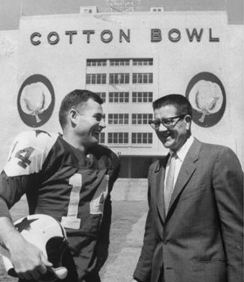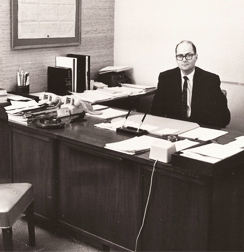© 2014 The Texas Lawbook.

By Natalie Posgate – (November 11) – Henry Gilchrist was a senior in high school on Dec. 7, 1941, the day the Japanese attacked Pearl Harbor. College was on the immediate horizon, but in an instant, everything changed.
Before he knew it, he was enrolled in the U.S. Army, spending his duty in the war defending the Panama Canal.
“Everybody’s plans were changed,” Gilchrist said.
Little did he know that many years later he would become one of the most legendary lawyers in Texas – and one who would do great things for the Dallas legal market.
For decades, he represented oil tycoon Clint Murchison and his two sons, John D. Murchison and Clint W. Murchison, Jr., in various transactions – the most famous being the purchase, establishment and handling of various legal matters for the Dallas Cowboys.

Gilchrist’s work in these matters brought prominence to Dallas at a time America’s memories of the city dwelled on the JFK shooting.
“He had a huge impact on increasing the profile of Dallas law firms on a national scale in the 1970s and 1980s,” said Bill Parrish, a former colleague of Gilchrist’s. “He was doing as sophisticated work as anybody in the country at a time when people didn’t recognize Texas firms – especially Dallas firms – for that quality of sophisticated work.”
Over the weekend Gilchrist celebrated his 90th birthday – and not as a retired lawyer. Now at Hunton & Williams, Gilchrist still goes into the office several times a week.
“I think I could be happy if I didn’t come in [to the office],” Gilchrist told The Texas Lawbook over lunch at the Petroleum Club. “But it’s good to get up, get dressed and have somewhere to go.
“Even if you don’t do much,” he chuckled.
A career in the law was never a premeditated idea for Gilchrist. He was born in Austin in 1924, but his civil engineer father’s work eventually led the family to College Station so Gibb Gilchrist could become the dean of the engineering school at Texas A&M College. Henry completed high school at A&M Consolidated, which was located near the college campus.
He was halfway through his senior year when the Japanese attacked Pearl Harbor, but because of a program called the Army Specialized Training Program, he did not have to immediately join American forces for World War II. The program was designed to allow college students to finish their education before entering active service in the Army. Thus, Gilchrist decided to follow his father’s footsteps by pursuing a bachelor’s degree in civil engineering.
The ASTR program, however, was cut short due to the escalation of the war, so Gilchrist instead found himself in Panama with the Coast Artillery to join the group protecting the Panama Canal from attack.
He stayed there until the war ended. When he returned to Texas, Gilchrist went back to A&M and completed his civil engineering degree in January 1948.
He enrolled in the University of Texas School of Law a week after he graduated.
He received his J.D. in 1950. The rest is history. He spent the majority of his legal career at what came to be known as Jenkens & Gilchrist – one of the most prestigious law firms in Texas history. The firm originally opened because Clint Murchison, Sr. needed lawyers to assist him with his business assets.
Throughout his career, Gilchrist – the fifth attorney to join the firm – worked on many significant deals for the Murchisons, including: the development of the Denver Club Building; the merger between TCO Industries, Inc. and Holiday Inns; the purchase of St. Louis Car Company; the purchase/establishment of the Dallas Cowboys; the hiring of the Dallas Cowboy Cheerleaders; the contract drafting for Cowboys general manager Tex Schramm and Cowboys coach Tom Landry; and the development of the Texas Stadium.
Gilchrist and the firm represented the Cowboys for about 25 years, until the Murchison family sold the team to H.R. “Bum” Bright in 1984.
Former Jenkens & Gilchrist colleagues say that as a leader, Gilchrist, who was managing partner at the firm for about 25 years, always remained calm, even in times that caused ultimate panic – such as the demise of the firm as a result of tax issues the firm’s Chicago office ran into with the Internal Revenue Service.
“Henry was always a stabilizing force in the firm,” said Marshall Simmons, a former litigation partner and the 11th attorney to join Jenkens & Gilchrist. “No matter how much the rest of us were on edge and got excited about something, Henry would always say, ‘Let’s just calm down. We can work it out.’ “
He displayed this quality during our interview at the Petroleum Club.
When asked what were the biggest disappointments of his career, he responded, “I don’t dwell on disappointments.”
“We’ve had so many successes,” he said. “Maybe there were disappointments when certain people you valued left the firm. But we’ve just been so extremely fortunate.”
When Jenkens & Gilchrist was forced to shut down in 2007, close to 100 attorneys from the firm’s Dallas, Houston and Austin offices found their new home at Hunton & Williams.
“The individual workload from Friday to Monday was virtually no change,” Gilchrist said. “We were extremely lucky that we were not all thrown out on the street. We kept the staff, kept some of our lawyers and it prospered.”

Parrish said firm management worked hard for that to happen – partially because Gilchrist built a culture in which everyone would look out for each other, which in this instance meant the firm found “a landing place for every lawyer, secretary and staff member” to its best ability.
“We were different from any firm I’m aware of that has been through that process,” said Parrish, who was at Jenkens & Gilchrist for about 30 years and served part of his time there as the firm’s Austin managing partner. “We never filed for bankruptcy or had a bad fight among the lawyers.”
Parrish ended up at DiNovo Price Ellwanger & Hardy, an Austin-based firm that was started up by former Jenkens & Gilchrist attorneys. Though he is a litigator and Gilchrist is a transactional attorney, Parrish said he still learned a lot from Gilchrist in the way he carried himself. He said Gilchrist taught him to treat people with kindness while remaining a strong advocate for the client.
“He’s maybe a dying breed,” Parrish said. “Today, so many lawyers think you have to act tough and beat your chest, but he has a quite dignified way in whatever he does. He could negotiate very hard but do it in a way that was not offensive to the other side.”
Simmons, who has known Gilchrist since 1967, recalled that at one point, the firm decided to go more casual in dress. But Gilchrist still showed up in a suit every day.
“When the firm voted to go everyday casual, I wore my tuxedo the next day (to protest),” Simmons said on a call from Santa Fe. “Everybody thought that was funny… but Henry didn’t think it was funny.”
Simmons said he did not continue to wear his tux, but Gilchrist never failed to show up to the office suit-and-tie-clad.
“Henry agreed with me that a lawyer ought to dress like a lawyer. That meant a coat and tie, so he continued to do that the rest of the time he was active,” Simmons said.
Gilchrist said he gets asked all the time about what his advice is to young lawyers. He said: “Learn your craft, work hard, be diligent, be easy to get along with and be active in the community so you can establish a base of friends and potential clients.”
When asked what his favorite thing about the practice of law is, his answer was more simple.
“It’s indoor work and no heavy lifting.”
© 2014 The Texas Lawbook. Content of The Texas Lawbook is controlled and protected by specific licensing agreements with our subscribers and under federal copyright laws. Any distribution of this content without the consent of The Texas Lawbook is prohibited.
If you see any inaccuracy in any article in The Texas Lawbook, please contact us. Our goal is content that is 100% true and accurate. Thank you.
